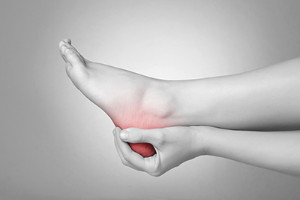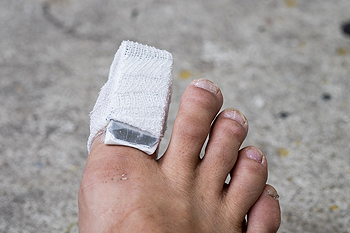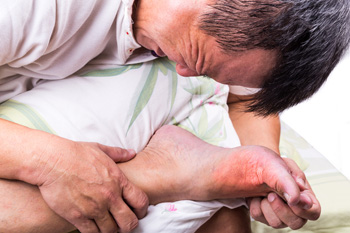Connect With Us
Blog
Items filtered by date: June 2022
Excessive Running or Jumping May Cause a Bruised Heel

A bruised heel can occur from the force of striking the ground repeatedly while running or jumping. This repeated trauma to the heel can damage blood vessels in the soft tissue and muscles in and around the heel. Even though the skin does not break, a bruised heel, or heel contusion, can result in bleeding under the skin. The pain caused by a bruised heel may respond to heat, ice, or both, and may also be alleviated with rest and elevation. Severely bruised heels may require the care of a podiatrist who can prescribe custom orthotics and shoes, physical therapy, and even prescription-strength medications. It is also important to have a podiatrist examine your injury in order to rule out other possible causes of pain in the heel, such as a fracture or plantar fasciitis.
Ankle and foot injuries are common among athletes and in many sports. They can be caused by several problems and may be potentially serious. If you are feeling pain or think you were injured in a sporting event or when exercising, consult with one of our podiatrists from New England Foot and Ankle. Our doctors will assess your condition and provide you with quality foot and ankle treatment.
Common Injuries
The most common injuries that occur in sporting activities include:
- Achilles Tendonitis
- Achilles Tendon Rupture
- Ankle Sprains
- Broken Foot
- Plantar Fasciitis
- Stress Fractures
- Turf Toe
Symptoms
Symptoms vary depending upon the injury and in some cases, there may be no symptoms at all. However, in most cases, some form of symptom is experienced. Pain, aching, burning, bruising, tenderness, tightness or stiffness, sensation loss, difficulty moving, and swelling are the most common symptoms.
Treatment
Just as symptoms vary depending upon the injury, so do treatment options. A common treatment method is known as the RICE method. This method involves rest, applying ice, compression and elevating the afflicted foot or ankle. If the injury appears to be more serious, surgery might be required, such as arthroscopic or reconstructive surgery. Lastly, rehabilitation or therapy might be needed to gain full functionality in the afflicted area. Any discomfort experienced by an athlete must be evaluated by a licensed, reputable medical professional.
If you have any questions, please feel free to contact one of our offices located in Chelmsford and Newburyport, MA . We offer the newest diagnostic and treatment technologies for all your foot care needs.
Buddy Taping or Surgery May Be Options for a Broken Toe

A broken toe can occur when a heavy object drops on it, or if it is stubbed against a piece of furniture. It generally causes immediate pain, and can look bruised and swollen. It is common for the surrounding ligaments and tendons to become damaged when a broken toe occurs, and walking can be difficult. A proper diagnosis consists of having an X-ray taken, in addition to assessing the alignment of the toes. If the fracture is mild, buddy taping may be an effective form of treatment. This is done by taping the broken toe to the toe next to it, and this can provide the stability that is needed as the healing process occurs. Some patients are able to wear a stiff-soled shoe that can help to eliminate toe movement. Surgery may be a necessary option to realign toes if they are significantly deformed. As healing takes place, it is beneficial to frequently elevate the foot which can help to reduce existing swelling. If you have fractured your toe, it is strongly suggested that you confer with a podiatrist as quickly as possible who can determine what the best course of treatment is for you.
Broken toes may cause a lot of pain and should be treated as soon as possible. If you have any concerns about your feet, contact one of our podiatrists from New England Foot and Ankle. Our doctors will treat your foot and ankle needs.
What Is a Broken Toe?
A broken toe occurs when one or more of the toe bones of the foot are broken after an injury. Injuries such as stubbing your toe or dropping a heavy object on it may cause a toe fracture.
Symptoms of a Broken Toe
- Swelling
- Pain (with/without wearing shoes)
- Stiffness
- Nail Injury
Although the injured toe should be monitored daily, it is especially important to have a podiatrist look at your toe if you have severe symptoms. Some of these symptoms include worsening or new pain that is not relieved with medication, sores, redness, or open wounds near the toe.
If you have any questions, please feel free to contact one of our offices located in Chelmsford and Newburyport, MA . We offer the newest diagnostic and treatment technologies for all your foot care needs.
Signs of Gout

Do you have pain in your big toe? Is your big toe swollen? Did these symptoms occur after being sick or becoming injured? If you answered yes to any of these questions, you may be afflicted with a condition known as gout. Gout is an inflammatory type of arthritis caused by a buildup of uric acid in the blood. Uric acid is naturally produced in the body to help you break down foods that contain purines. Once the purines are broken down, they are cleansed from the body through urine. If something interferes with this process, the buildup of uric acid can turn into urate crystals that collect around soft tissues and joints like the big toe. This can result in inflammation or gout. Men are said to be more susceptible to gout, as are those who eat foods rich in purines. Genetics, health problems like diabetes or high cholesterol, being obese, those who drink alcohol, and those who take diuretics may have an increased risk of developing gout. The pain from gout can be so severe it can interfere with walking and other daily activities. If you think you have gout, make an appointment to see a podiatrist for an accurate diagnosis and a treatment plan.
Gout is a foot condition that requires certain treatment and care. If you are seeking treatment, contact one of our podiatrists from New England Foot and Ankle. Our doctors will treat your foot and ankle needs.
What Is Gout?
Gout is a type of arthritis caused by a buildup of uric acid in the bloodstream. It often develops in the foot, especially the big toe area, although it can manifest in other parts of the body as well. Gout can make walking and standing very painful and is especially common in diabetics and the obese.
People typically get gout because of a poor diet. Genetic predisposition is also a factor. The children of parents who have had gout frequently have a chance of developing it themselves.
Gout can easily be identified by redness and inflammation of the big toe and the surrounding areas of the foot. Other symptoms include extreme fatigue, joint pain, and running high fevers. Sometimes corticosteroid drugs can be prescribed to treat gout, but the best way to combat this disease is to get more exercise and eat a better diet.
If you have any questions please feel free to contact one of our offices located in Chelmsford and Newburyport, MA . We offer the newest diagnostic and treatment technologies for all your foot and ankle needs.
Wounds That Don't Heal Need to Be Checked
Young Children and Walking Barefoot

Children’s feet may look like miniature versions of adult feet, but this is not true. They differ in shape and will change as they grow. The first year of life brings ample fat pads on the soles helping the feet to be soft and flexible. The arch will develop as the child begins to walk, and the feet will grow in length and width. It is beneficial for parents to have their child walk barefoot in order to help to strengthen the entire foot. The toes and the arch become stronger as the toes grip the floor, and growth can be restricted when tight shoes are worn. When children start to wear their first pair of shoes, it helps their feet when they have adequate cushioning and stability. Children of all ages can find it easier to wear shoes when they are easy to close, in addition to preventing feet from slipping. Research has indicated the average life of a pair of children’s shoes is four months, and it is advised that they be replaced approximately within this time frame. It is important for parents to purchase new shoes at the appropriate time because this can help to protect the feet against unwanted foot conditions. If you would like more information about what type of shoes to buy for your child, please consult with a podiatrist who can guide you in the right direction.
Making sure that your children maintain good foot health is very important as they grow. If you have any questions, contact one of our podiatrists of New England Foot and Ankle. Our doctors can provide the care you need to keep you pain-free and on your feet.
Keeping Children's Feet Healthy
Having healthy feet during childhood can help prevent medical problems later in life, namely in the back and legs. As children grow, their feet require different types of care. Here are some things to consider...
Although babies do not walk yet, it is still very important to take care of their feet.
Avoid putting tight shoes or socks on his or her feet.
Allow the baby to stretch and kick his or her feet to feel comfortable.
As a toddler, kids are now on the move and begin to develop differently. At this age, toddlers are getting a feel for walking, so don’t be alarmed if your toddler is unsteady or ‘walks funny’.
As your child gets older, it is important to teach them how to take care of their feet.
Show them proper hygiene to prevent infections such as fungus.
Be watchful for any pain or injury.
Have all injuries checked by a doctor as soon as possible.
Comfortable, protective shoes should always be worn, especially at play.
If you have any questions please feel free to contact one of our offices located in Chelmsford and Newburyport, MA . We offer the newest diagnostic and treatment technologies for all your foot and ankle needs.
Blog Archives
- April 2025
- March 2025
- February 2025
- January 2025
- December 2024
- November 2024
- October 2024
- September 2024
- August 2024
- July 2024
- June 2024
- May 2024
- April 2024
- March 2024
- February 2024
- January 2024
- December 2023
- November 2023
- October 2023
- September 2023
- August 2023
- July 2023
- June 2023
- May 2023
- April 2023
- March 2023
- February 2023
- January 2023
- December 2022
- November 2022
- October 2022
- September 2022
- August 2022
- July 2022
- June 2022
- May 2022
- April 2022
- March 2022
- February 2022
- January 2022
- December 2021
- November 2021
- October 2021
- September 2021
- August 2021
- July 2021
- June 2021
- May 2021
- April 2021
- March 2021
- February 2021
- January 2021
- December 2020
- November 2020
- October 2020
- September 2020
- August 2020
- July 2020
- June 2020
- May 2020
- April 2020
- March 2020
- February 2020
- January 2020
- December 2019
- November 2019
- October 2019
- September 2019
- August 2019
- July 2019
- June 2019
- May 2019
- April 2019
- March 2019
- February 2019
- January 2019
- December 2018
- November 2018
- October 2018
- September 2018
- August 2018
- July 2018
- June 2018
- May 2018
- April 2018
- March 2018
- February 2018
- January 2018
- December 2017
- November 2017
- October 2017
- September 2017
- August 2017
- July 2017
- June 2017
- May 2017
- April 2017
- March 2017
- February 2017
- March 2016

